Overview
The article highlights the emotional challenges that healthcare providers face in their daily routines. It recognizes that the overwhelming administrative burdens can detract from the time spent with patients, ultimately affecting the quality of care.
By providing effective examples of nursing SOAP notes, the article illustrates how structured documentation methods can alleviate some of these pressures. These methods, such as SOAP, streamline workflows, allowing nurses to devote more time to meaningful patient interactions rather than getting lost in paperwork.
Imagine the difference it could make—when nurses can focus on their patients, the potential for improved healthcare outcomes increases significantly. This shift not only enhances patient care but also fosters a more fulfilling work environment for healthcare providers.
We encourage you to explore these documentation practices further. By embracing structured methods, you can help create a more compassionate and efficient healthcare experience for both patients and providers.
Introduction
In the fast-paced realm of healthcare, nurses often find themselves overwhelmed by a whirlwind of administrative tasks that can overshadow their primary mission: patient care. This struggle can be emotionally taxing, as the dedication to patients can sometimes feel compromised by the demands of paperwork.
However, with the rise of innovative technologies like AI-driven solutions, there is a promising opportunity to streamline documentation processes. Imagine reclaiming valuable time to focus on what truly matters—your patients. Yet, a crucial question arises: how can healthcare professionals effectively integrate these new methods while ensuring the quality and accuracy of their documentation?
This article delves into seven essential charting nursing SOAP note examples that not only enhance efficiency but also empower nurses to provide compassionate and attentive care. By embracing these solutions, you can alleviate some of the burdens and reconnect with the heart of nursing—caring for those in need. Let's explore how these tools can transform your practice and improve patient outcomes.
CosmaNeura: AI-Driven Solutions for Efficient Nursing Charting
In the demanding world of healthcare, nurses often face overwhelming administrative tasks that can detract from their ability to provide compassionate care. CosmaNeura understands these emotional challenges and harnesses cutting-edge AI technology to revolutionize the charting nursing soap note example processes. By automating regular record-keeping tasks, our platform allows nurses to dedicate more time to their patients, alleviating administrative burdens that have been highlighted in thorough customer interviews.
This transformation not only streamlines workflows but also significantly enhances the quality of interactions, reinforcing our commitment to compassionate healthcare. With features such as real-time transcription and diagnostic assistance, CosmaNeura ensures that nursing records are both accurate and prompt, ultimately leading to improved healthcare outcomes.
Consider the case studies from The Permanente Medical Group, which reveal that AI-assisted documentation can save physicians an estimated 15,700 hours annually—equivalent to approximately 1,794 working days. Furthermore, 56% of individuals reported an enhanced quality of their visits due to AI integration, with no adverse effects noted. As Kristine Lee, MD, associate executive director of virtual medicine and technology at TPMG, wisely states, "We have an opportunity and duty to utilize groundbreaking AI that enhances healthcare and boosts our physicians’ abilities, while promoting their well-being."
The implementation of AI in nursing documentation, such as charting nursing soap note example, is not merely a technological advancement; it is a vital step toward revolutionizing treatment and enriching the overall medical experience. We invite you to explore how CosmaNeura can support you in your mission to provide exceptional care.
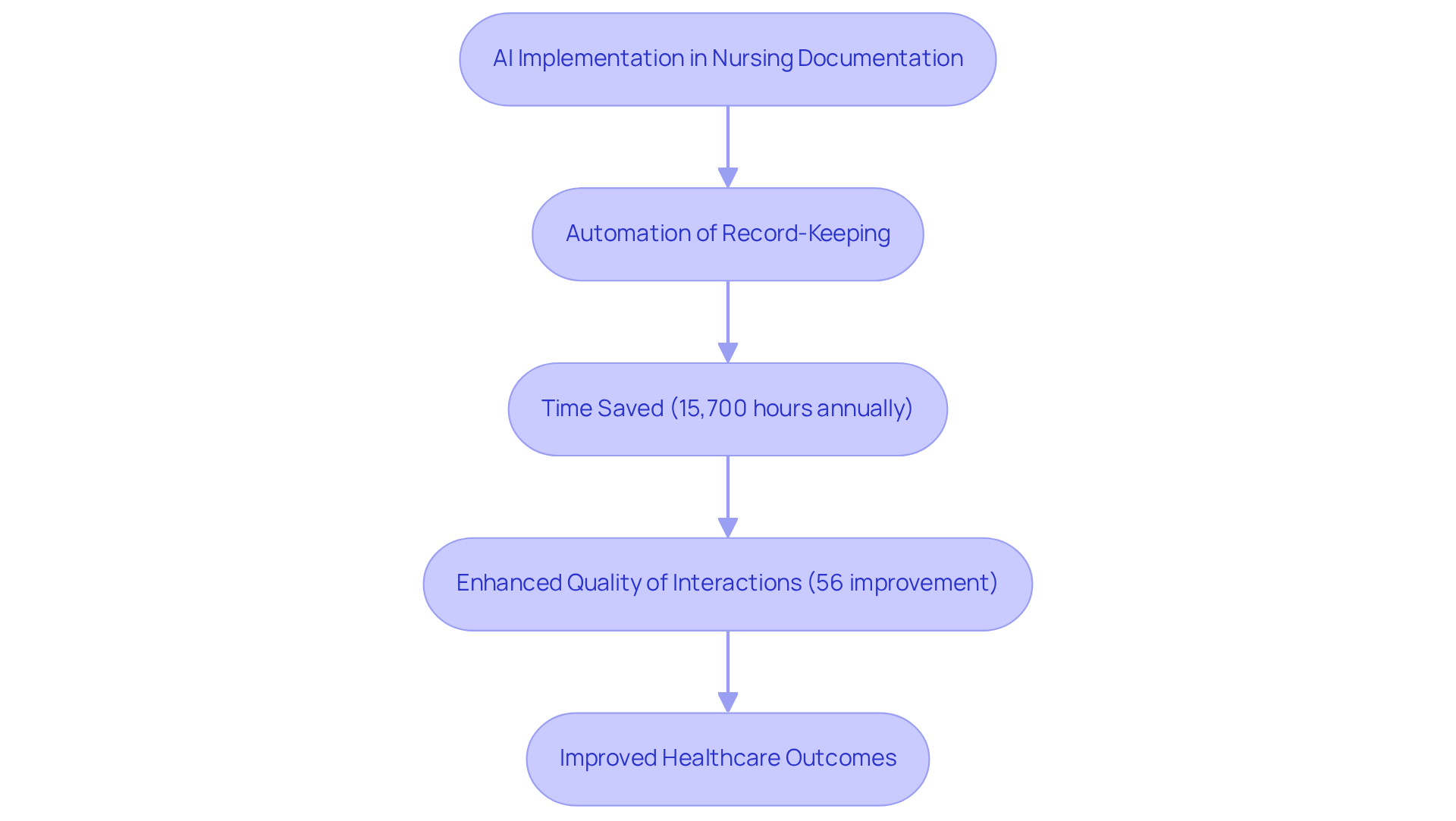
SOAP Note Example: Comprehensive Patient Assessment
An example of charting nursing soap notes includes four essential components: Subjective, Objective, Assessment, and Plan. Have you ever felt overwhelmed by the demands of documentation? For instance, a nurse might document using a charting nursing soap note example:
- Subjective: Patient reports increased pain in the lower back.
- Objective: Vital signs stable, tenderness noted in the lumbar region, as illustrated in the charting nursing soap note example.
- Assessment: Likely muscle strain, which could be documented in a charting nursing soap note example.
- Plan: Administer pain relief and schedule follow-up in one week, as demonstrated in a charting nursing soap note example.
This organized format, which serves as a charting nursing soap note example, not only gathers all relevant individual information but also improves care planning and communication among medical professionals.
By following this approach, clinicians can guarantee thorough records that support effective treatment strategies and enhance client outcomes. Imagine how much smoother your workflow could be! Moreover, utilizing generative AI can improve the documentation process by automating administrative duties. This allows medical professionals to concentrate more on client interactions, reducing the burden of time-consuming documentation.
Ultimately, this promotes better communication and collaboration among healthcare teams, resulting in enhanced support for individuals. Consider how these improvements can transform your practice and the care you provide. Embracing these tools can lead to a more fulfilling experience for both you and your patients.
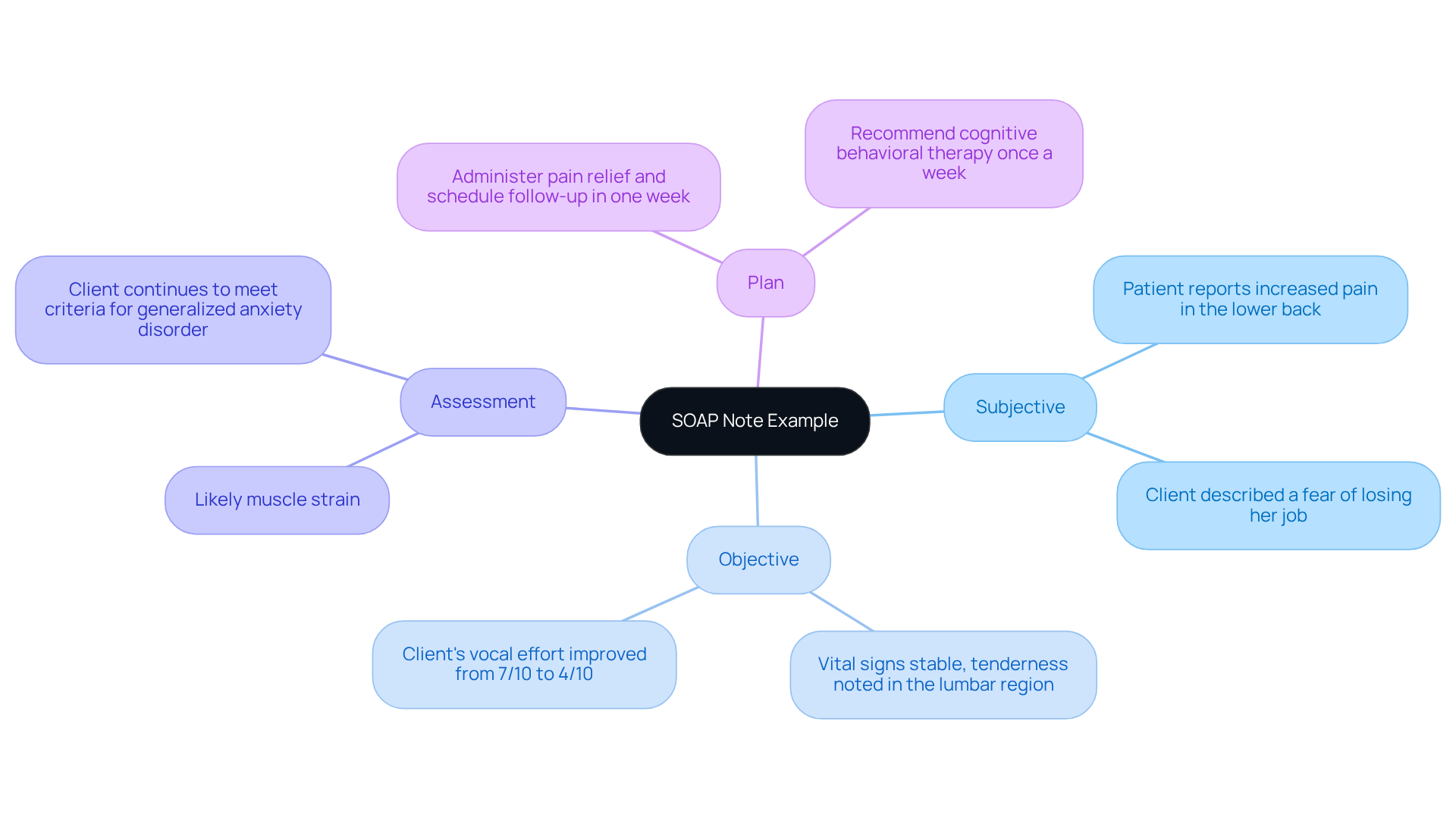
Narrative Notes Example: Capturing Patient Stories
Narrative notes empower nurses to capture individual experiences with profound depth and detail. For instance, a nurse might document: 'Patient expressed feelings of anxiety about upcoming surgery, sharing concerns about recovery. Engaged in conversation to address fears and provided reassurance.' This approach not only records vital clinical details but also strengthens the bond between the individual and provider, ultimately enhancing the overall treatment experience.
Efficient records serve as an essential resource for communication among healthcare teams, ensuring continuity of support and nurturing trust. Have you considered how these narratives can transform patient care? As highlighted by nursing leaders, the ability to express individual stories through records is crucial for involving individuals in their health journey. It emphasizes the importance of understanding their unique viewpoints and concerns, allowing for a more compassionate approach to care.

Charting by Exception Example: Simplifying Documentation
Charting by exception is a compassionate approach that focuses on recording only the notable discoveries or changes in a patient’s condition. This method not only simplifies the record-keeping process but also alleviates some of the burdens healthcare providers face. For example, a nurse might note: Patient's blood pressure stable; no new complaints. Previous concerns about pain resolved. By reducing unnecessary paperwork, charting by exception allows nurses to dedicate more time to their essential responsibilities, fostering a more responsive environment for patient care.
Imagine the relief of minimizing administrative tasks—this method enhances efficiency in care records, empowering nurses to proactively address patients' needs. However, implementing this approach requires educating staff on identifying significant findings, ensuring that vital information is consistently captured without overwhelming paperwork. Optimal methods support this efficient practice, enhancing the quality of interactions with patients and promoting a structured record-keeping process.
Moreover, the integration of generative AI can further enhance this practice by automating routine tasks. This allows healthcare providers to focus on meaningful interactions with their patients. As Trei Tackett, a nurse practitioner at Nexus Medicine, insightfully noted, The traditional system made it difficult to track and manage data regarding individuals in a manner that facilitated proactive decision-making. This highlights the importance of adopting effective record-keeping practices.
To implement generative AI in charting nursing soap note example, medical providers can utilize AI-powered tools that automatically flag significant changes in patient conditions. This ensures critical information is captured without unnecessary record-keeping. Additionally, embracing a centralized platform, as demonstrated in Nexus Medicine's transition, can significantly enhance data management and boost engagement with patients. By adopting these innovative practices, we can create a more supportive and efficient healthcare environment.
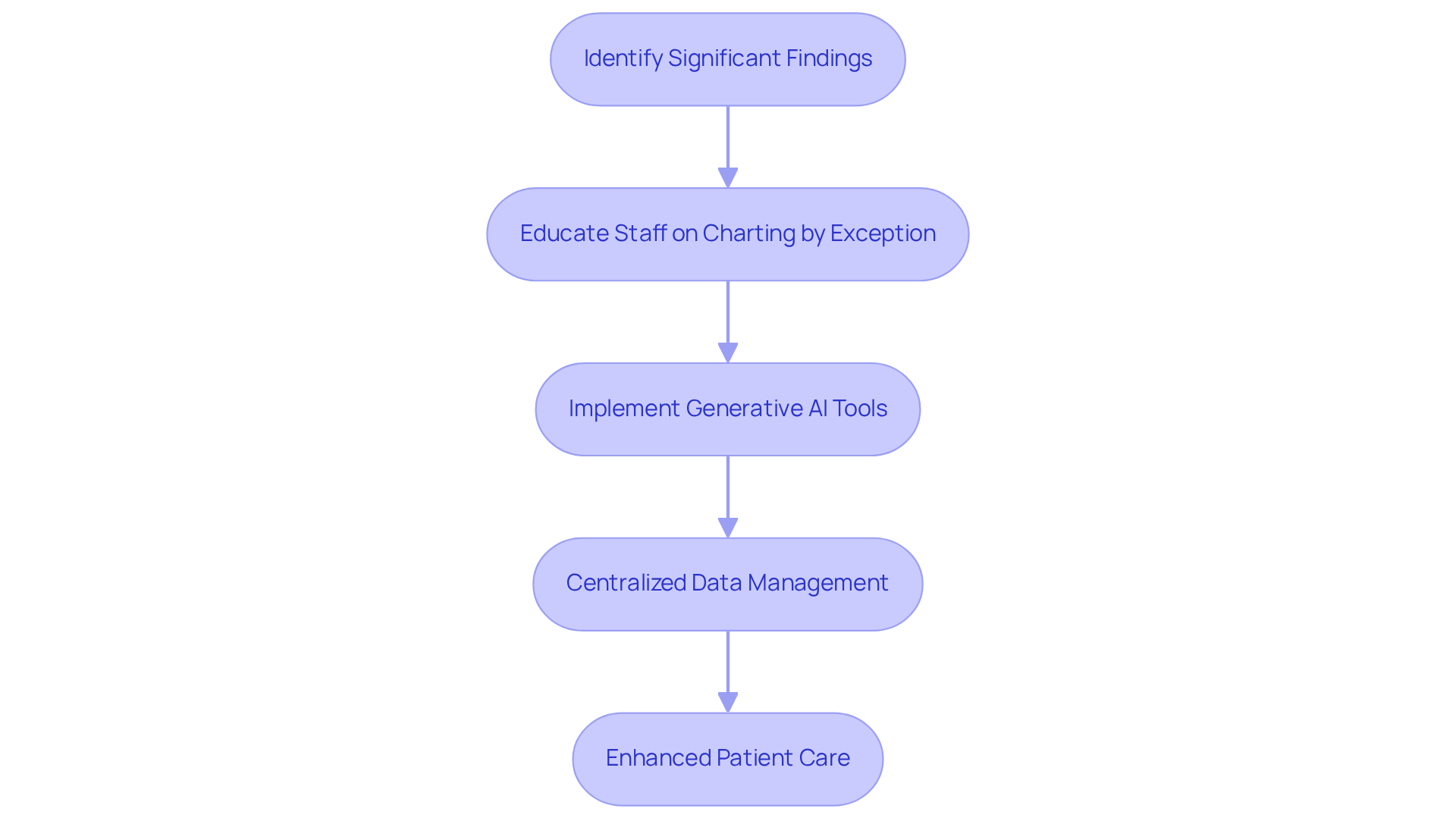
PIE Charting Example: Structured Patient Care Documentation
In the world of healthcare, providers often face emotional challenges that can impact patient care. The fragmented nature of medical systems adds to this burden, making effective communication essential. For instance, consider a situation where a patient reports difficulty breathing. The documentation might read:
- Problem: Patient reports difficulty breathing.
- Intervention: Administered bronchodilator as prescribed, as noted in the charting nursing soap note example.
- Evaluation: According to the charting nursing soap note example, the patient's breathing improved within 15 minutes.
This structured approach not only clarifies nursing procedures but also fosters better communication among medical team members, addressing the urgent need for improved coordination in treatment.
Moreover, integrating telemedicine and remote monitoring can significantly enhance accessibility for patients. This ensures ongoing support, even beyond conventional environments, nurturing a continuous connection between providers and patients. As we embrace advancements like generative AI, we can streamline administrative tasks, allowing medical professionals to focus more on what truly matters: patient support.
It's also crucial to consider regulatory concerns, such as HIPAA, which impact communication and coordination in healthcare. By addressing these concerns, we can create a more efficient and patient-centered healthcare environment. Together, let’s strive for solutions that not only alleviate administrative burdens but also enhance the quality of care we provide.

Focus (DAR) Charting Example: Prioritizing Patient Needs
In the demanding world of healthcare, providers often face emotional challenges, such as feeling overwhelmed by administrative tasks. Focus charting, which includes a charting nursing soap note example utilizing the DAR format (Data, Action, Response), offers a solution to this common struggle. For instance, consider this example:
- Data: Patient reports increased anxiety.
- Action: Provided calming techniques and education on anxiety management.
- Response: Patient appeared more relaxed and engaged in discussion.
This structured approach, akin to a charting nursing soap note example, not only addresses patient concerns swiftly but also enhances the overall treatment experience.
By integrating innovative AI solutions like CosmaNeura's Agentic Platform, healthcare providers can alleviate some of these burdens. Imagine simplifying record-keeping tasks, reducing administrative loads, and dedicating more time to meaningful interactions with patients. The integration of generative AI not only boosts efficiency but also fosters a more patient-centered approach, allowing for deeper connections during consultations.
Ultimately, this shift enhances the quality of service, ensuring that individual needs are prioritized and effectively managed. How might your practice benefit from such advancements? Embracing these tools can transform your interactions, making them more impactful and compassionate.

Nursing Documentation Dos and Don'ts: Best Practices
In the demanding world of healthcare, timely documentation is crucial. Do you ever feel overwhelmed by the administrative tasks that take time away from patient care? By documenting in a timely manner and using clear, concise language, you can alleviate some of that burden.
Here are some best practices to keep in mind:
- Always ensure accuracy in all entries.
- Avoid vague language that can lead to misunderstandings.
- Steer clear of documenting opinions or assumptions.
- Refrain from using unclear abbreviations.
Adhering to these practices not only makes your records dependable but also serves as a valuable asset for both you and your patients. Remember, when you document effectively, you’re not just keeping records; you’re enhancing the quality of care you provide. Let's commit to making our documentation as clear and effective as possible.
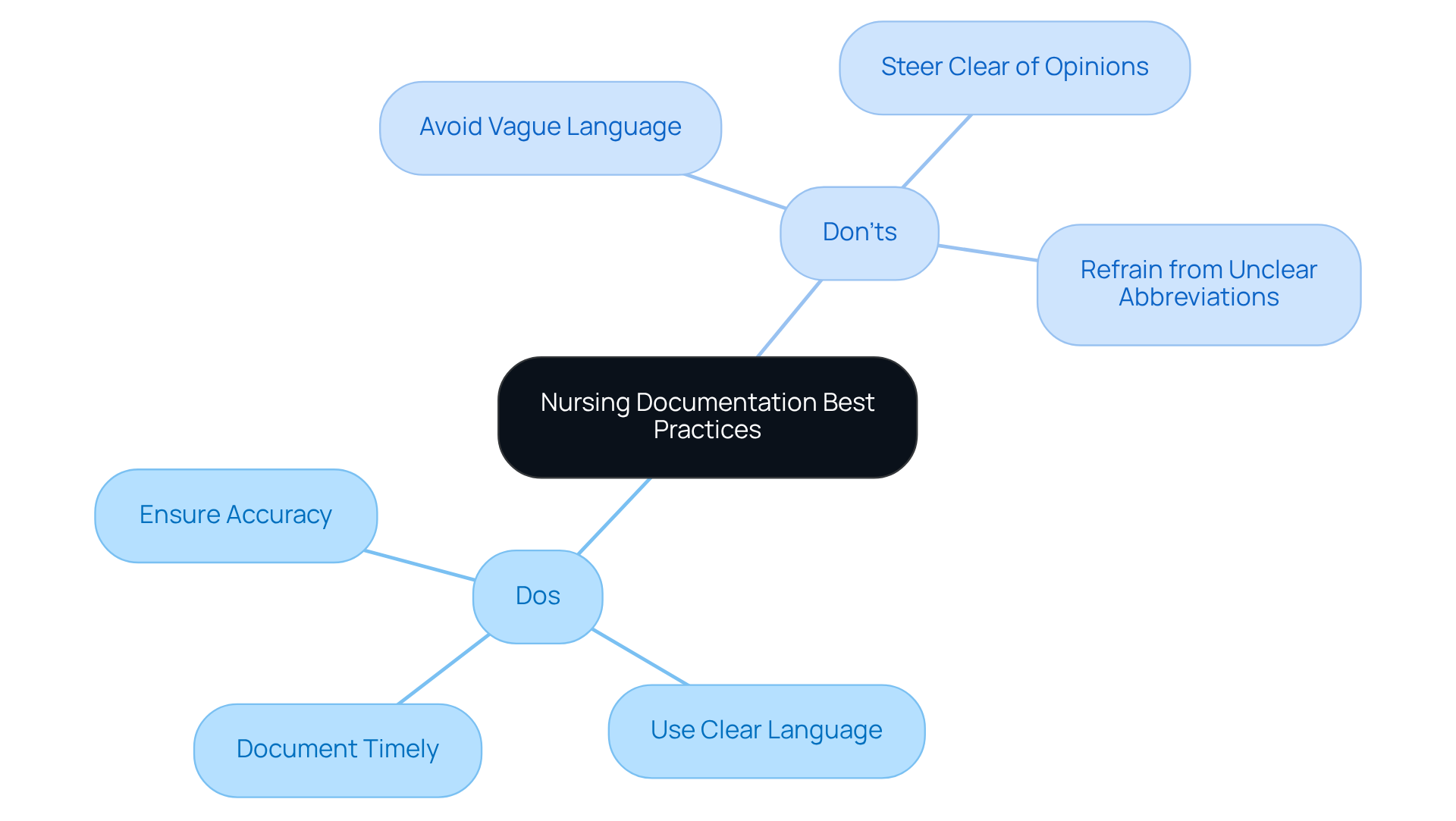
Incident Report Example: Importance of Accurate Documentation
An effective incident report is crucial in the healthcare environment. It should include essential details such as the date, time, location, individuals involved, and a comprehensive description of the event. For instance: 'On October 15, 2025, at 10:00 AM, an individual fell while trying to get out of bed.' Immediate assessment revealed no injuries, and staff were notified while safety protocols were reviewed.
Accurate incident reporting is not just a procedural formality; it plays a vital role in identifying trends and implementing preventive measures. Did you know that healthcare establishments that prioritize comprehensive record-keeping experience a 30% decrease in repeat incidents? This statistic underscores the significance of careful record maintenance. Nursing leaders emphasize that accurate records foster a culture of safety and responsibility, ultimately leading to improved healthcare outcomes.
As one nursing leader poignantly stated, 'Precise record-keeping is the foundation of safety for individuals receiving care; it enables us to learn from events and enhance our methods.' To write effective incident reports, ensure clarity and completeness by including all relevant details, using objective language, and following your facility's reporting guidelines. By doing so, you contribute to a safer environment for everyone.
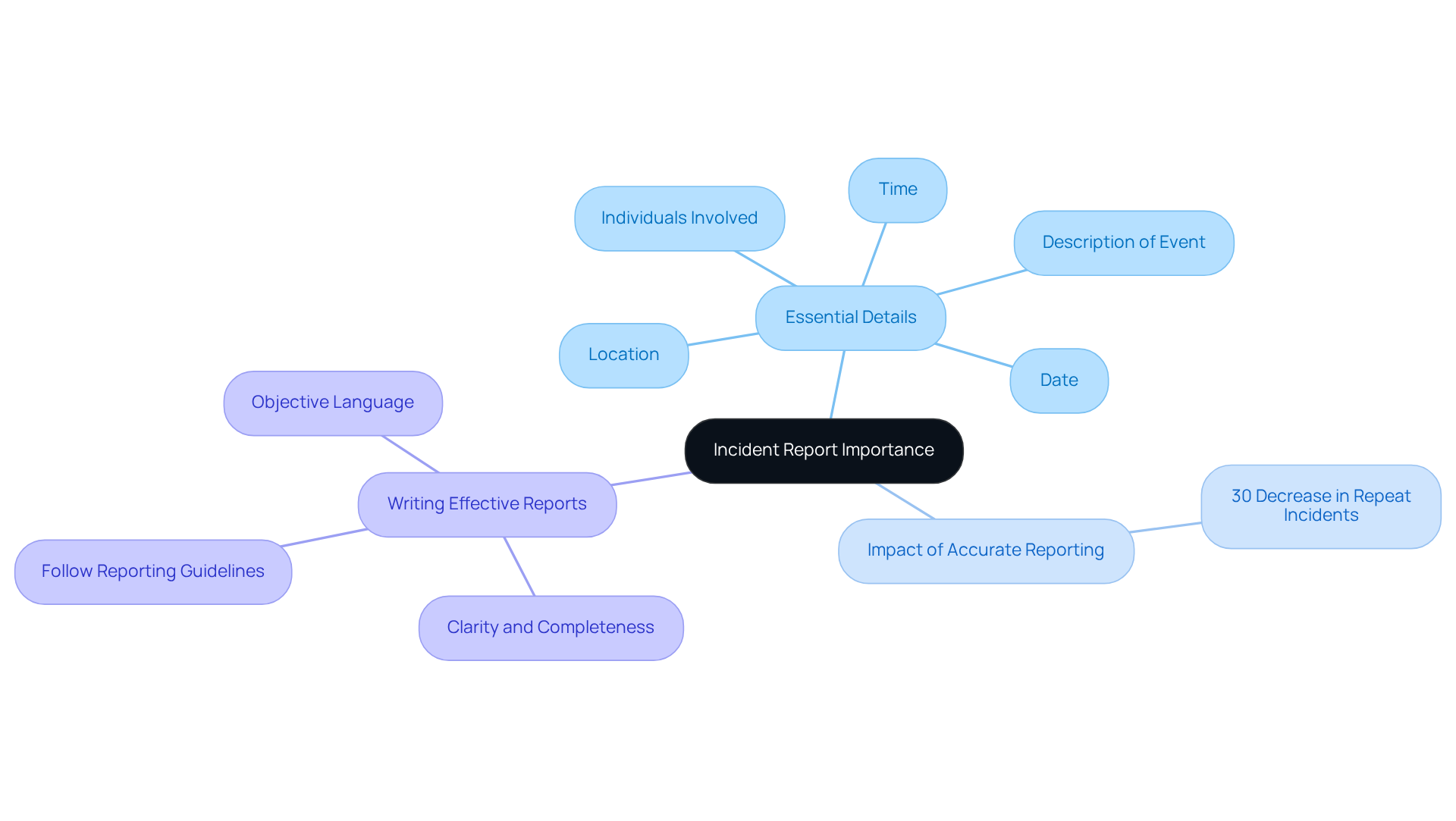
Telehealth Documentation Example: Adapting to Virtual Care
In the evolving landscape of healthcare, telehealth records must encompass the same essential elements as in-person appointments. This not only upholds the quality of service but also addresses the emotional challenges faced by providers in adapting to virtual care.
Consider this charting nursing soap note example: 'Patient seen via telehealth on October 20, 2025.'.
- Subjective: Reports persistent cough as documented in the charting nursing soap note example.
- Objective: The charting nursing soap note example shows no visible distress.
- Assessment: Possible upper respiratory infection documented in the charting nursing soap note example.
- Plan: The plan includes charting nursing soap note example, which involves prescribing medication and scheduling a follow-up.
Such thorough documentation ensures that virtual services are recorded comprehensively, preserving the standard of client treatment.
By maintaining these standards, we can alleviate some of the administrative burdens that often impact patient care. This commitment to quality in telehealth fosters trust and continuity in the patient-provider relationship.
Are we doing enough to support our patients in this new format? As we navigate these changes, let us prioritize clear and compassionate communication, ensuring that every patient feels seen and heard, even from a distance.
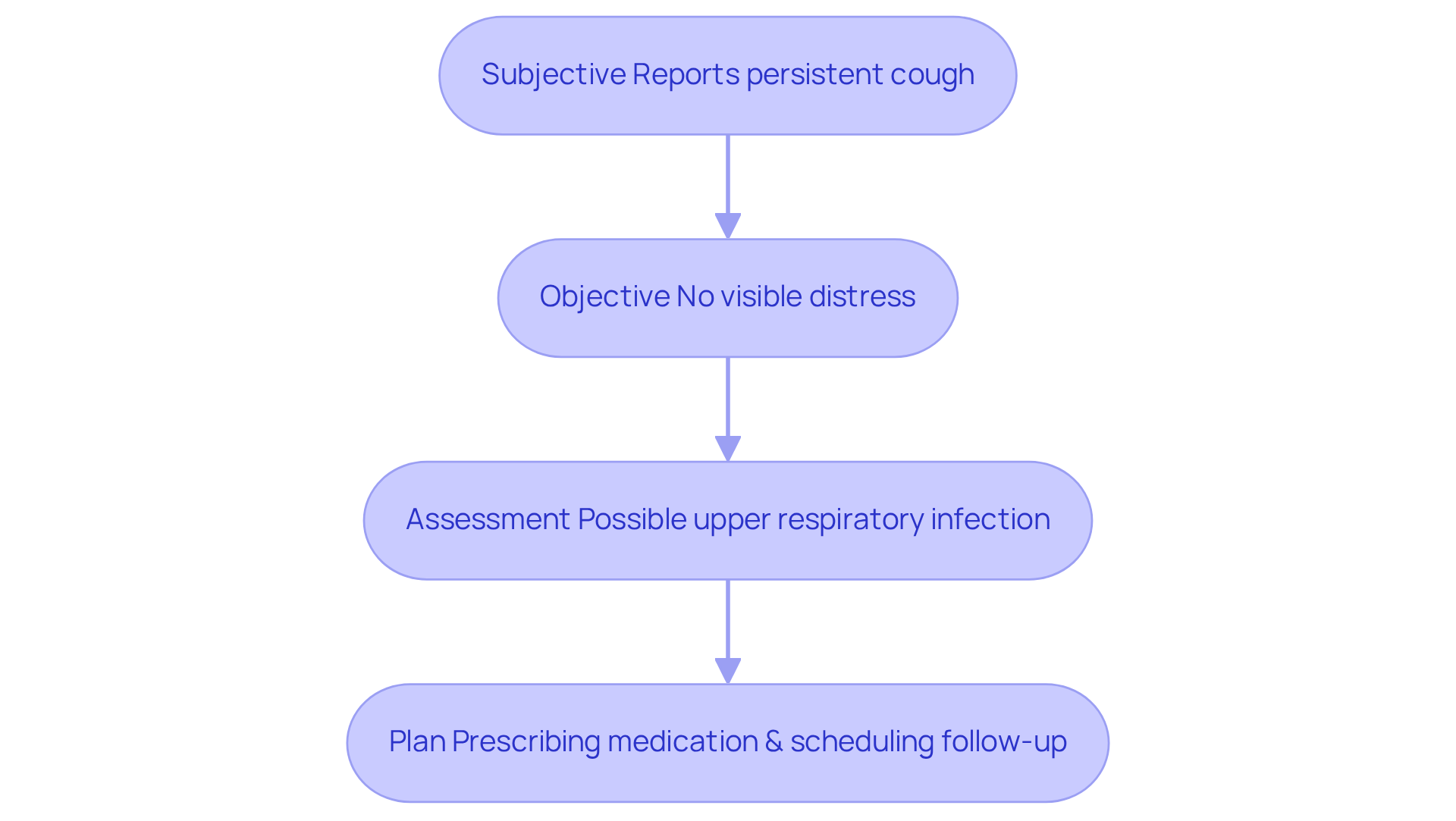
Overview of Nurse Charting Types: Diverse Documentation Methods
Nurses often face emotional challenges in their demanding roles. With the weight of administrative duties, how can they ensure that patient care remains a priority? Charting methods such as SOAP, narrative, charting by exception, PIE, and focus (DAR) charting, including the charting nursing soap note example, are designed to alleviate some of that burden. Each method offers unique advantages tailored to specific clinical scenarios, helping nurses navigate their responsibilities more effectively.
For instance, charting nursing soap note example is particularly beneficial for thorough evaluations, as it provides organized records that enhance clarity and continuity of treatment. On the other hand, charting by exception simplifies the recording process, allowing nurses to focus more on meaningful interactions with their clients rather than being bogged down by paperwork. This shift in focus can foster a more compassionate approach to care, which is vital in today’s healthcare environment.
Current trends indicate a move towards electronic record-keeping systems, which significantly reduce human errors and enhance overall efficiency in nursing practices. These systems not only improve the precision of client records but also empower nurses to dedicate more time to person-centered care. Imagine the difference it could make when nurses can spend more time connecting with patients, understanding their needs, and providing the care they deserve.
As healthcare continues to evolve, it’s crucial for nurses to understand and select the most appropriate documentation methods. This knowledge can optimize workflows and ultimately improve patient outcomes. Let’s embrace these advancements together, ensuring that every nurse can provide the best possible care while feeling supported in their roles.

Conclusion
In the realm of nursing, effective documentation is not just a task; it is a cornerstone of quality patient care. Many healthcare providers face emotional challenges, overwhelmed by the demands of record-keeping. The exploration of various charting methods, such as SOAP notes, narrative documentation, and charting by exception, highlights the importance of structured and precise record-keeping. By adopting these diverse approaches, nurses can alleviate administrative burdens, allowing them to focus on what truly matters—providing compassionate care to their patients.
Throughout the article, key insights emphasize the transformative potential of AI-driven solutions like CosmaNeura. These tools streamline the documentation process and enhance the quality of interactions between healthcare providers and patients. Imagine the difference it could make when innovative technologies not only save time but also foster a more patient-centered approach. This enables nurses to prioritize individual needs and improve overall healthcare outcomes. The case studies and examples provided illustrate how these methods can lead to better communication and collaboration within healthcare teams.
As the healthcare landscape continues to evolve, embracing efficient documentation practices becomes increasingly vital. It is essential for nursing professionals to stay informed about the latest tools and methodologies that can enhance their workflows. By prioritizing clear and effective documentation, nurses can ensure that they are not only meeting regulatory requirements but also contributing to a safer and more supportive environment for their patients.
Key Solutions:
- Adopt diverse charting methods
- Utilize AI-driven tools like CosmaNeura
- Prioritize patient-centered approaches
The call to action is clear: let us champion these advancements in nursing documentation to foster a healthcare system that values both efficiency and compassion. Together, we can create a nurturing environment that uplifts both patients and healthcare providers.




